Unravelling the mysteries of meringue
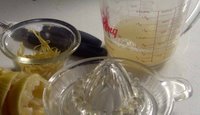 As you know, I didn't finish Fiver's Leo in time for his birthday, but I still managed to make him a birthday cake. (or pie, in this case.) As the knitting continues in the background (no progress shots until there is some actual visible progress), I will share with you a few revelations I had on Saturday morning while making Fiver's specially requested Lemon Meringue Birthday Pie.
As you know, I didn't finish Fiver's Leo in time for his birthday, but I still managed to make him a birthday cake. (or pie, in this case.) As the knitting continues in the background (no progress shots until there is some actual visible progress), I will share with you a few revelations I had on Saturday morning while making Fiver's specially requested Lemon Meringue Birthday Pie.I had never made a lemon meringue pie, so of course, I turned to the internet for assistance. I reviewed lots of recipes and finally settled on a combination of three: Grandma's Lemon Meringue Pie, Jan's Lemon Meringue Pie, and Extra Tangy Lemon Meringue Pie. Grandma is from Texas, while Jan and the Extra Tangy are both from Australia. Sometimes American dessert recipes are too sweet for even my palate, so I relied on Grandma for some helpful hints while taking measurements and method from the other two.
The first major revelation I had while researching all these recipes is the entire reason for the existence of lemon meringue pie in the first place. It's so simple. For generations, cooks must have been making lemon custard tarts and incorporating egg yolks for extra richness. (I know my very favourite show-stopper of a dessert is Jamie Oliver's lemon and lime tart, which calls for something like 8 egg yolks.) Once upon a time, some enterprising or frugal cook decided the egg whites did nothing to deserve being cast aside and decided to whip those whites up and add them to the top of the lemon pie. Voila! Lemon Meringue Pie. What led me to this earth shattering discovery was the uncanny fact that EVERY recipe directed that the number of yolks to be used in the filling was the same as the number of whites to be used in the meringue.
Feeling pretty smart, I set to making the filling, carefully following Jan's measurements (with some modifications, I admit, influenced by Grandma) but paying attention to Extra Tangy's more descriptive method. Basically you chuck all the filling ingredients together and bring to the boil, beat rapidly for a minute, and let cool. It was a pretty ugly stage of preparations, and just after I took this action shot (with blurry spoon forming dark shadow at lower left) my father wandered in and asked why the pie filling wasn't yellow. (In response I rolled my eyes and said 'Daaaaaaaaaaad' - which is of course my response to all questions I don't know the answer to and quite frankly am fretting about myself.)
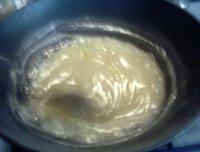 (Answer to why the filling is not yellow - I fortunately found out later - adding the egg yolks makes the filling yellow.)
(Answer to why the filling is not yellow - I fortunately found out later - adding the egg yolks makes the filling yellow.)My second revelation came to me during this process. Basically making the lemony filling is a jam-making process. Hence the existence of Lemon Meringue Pie and not, say Apple Meringue Pie. Lemon juice and zest naturally contains a good amount of pectin and for this reason is often added to jams of other fruits to aid setting. You couldn't really get a nice, set, gelatinous filling with most other fruits which are low in pectin without the aid of some yucky powders made from parts of animals we shan't discuss.
So here is my filling, nice and cool-ish (because Grandma and Jan couldn't agree over whether the pre-baked pie shell should be filled with cool or warm filling) being placed in my Extra Tangy pie crust. If I had this to do all over again, I wouldn't take Extra Tangy's advice on the crust - E.T. added no sugar to the crust (but did add almond meal which I thought sounded nice) but it does fall a bit flat on the tongue I have to say - a pie shell requires at least a smidgin of icing sugar to jazz it up.
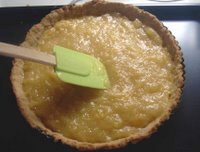 I'm sorry I didn't take an action photo of beating the egg whites but my new beaters (purchased from the great Professional Photographer Ashley closing down sale) scare me and require my undivided attention for fear that ingredients will be flung round the room in a frenzy...
I'm sorry I didn't take an action photo of beating the egg whites but my new beaters (purchased from the great Professional Photographer Ashley closing down sale) scare me and require my undivided attention for fear that ingredients will be flung round the room in a frenzy...I followed Grandma's advice to the letter with the meringue. She was the only one who called for cream of tartar in her meringue (which I always have on hand for a traditional family shortbread recipe, but use only about 1/4 teaspoon a year; hence any use of cream of tartar is welcome in my kitchen). What Grandma DIDN'T tell me was the handy trick that you can use the blade of a knife to 'pull' the peaks up (thanks Extra Tangy!)
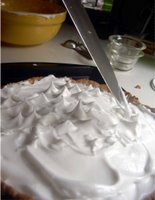 And here is the finished product, fresh from the fridge, where I let it cool after baking because who wants hot lemon meringue pie? ugh!
And here is the finished product, fresh from the fridge, where I let it cool after baking because who wants hot lemon meringue pie? ugh!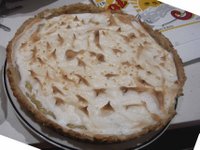 The moment of truth was slicing into the pie (a wet knife is apparently best, according to Grandma, I took her word for it). Luckily the contents didn't splodge out onto the plate and a firm profile was maintained for the duration of the pie's life.
The moment of truth was slicing into the pie (a wet knife is apparently best, according to Grandma, I took her word for it). Luckily the contents didn't splodge out onto the plate and a firm profile was maintained for the duration of the pie's life. At this point, I still cannot explain why egg whites become fluffy when you beat them. That will have to remain one of life's deep mysteries...
At this point, I still cannot explain why egg whites become fluffy when you beat them. That will have to remain one of life's deep mysteries...



<< Home